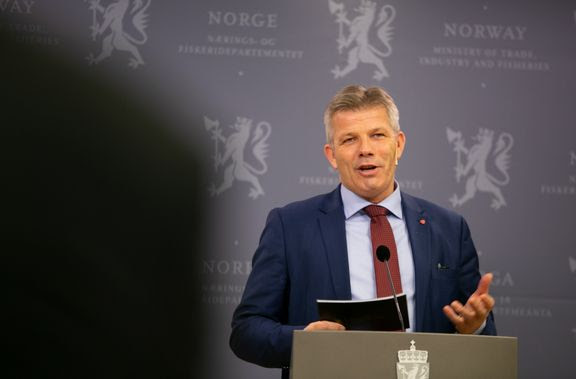The Ministry of Trade and Industry has announced the colours of the 13 different production areas for salmon, trout and rainbow trout farming. The decision can give a growth of just over 21,000 tonnes.
“We are now ensuring further growth in the areas where the impact of salmon lice on wild salmon is acceptable. It will facilitate further growth to create more jobs, more Norwegian food production, greater value creation and increased export revenues for Norway,” Minister of Fisheries and Marine Affairs Bjørnar Skjæran said in a statement.
“At the same time, we take the wild axis into account seriously by reducing production capacity where the impact is unacceptable.”
The colour is set based on scientific assessments of salmon lice’s impact on wild salmon for the years 2020 and 2021. Farmers in eight of the country’s thirteen production areas are given the green light. This means that they will have the opportunity to increase production. Three areas get yellow light and two areas get red light. In the red areas, production capacity must be reduced.

Still red light in two areas
The Minister of Fisheries and Marine Affairs has now determined which colours the areas should have:
- Eight production areas (PO) get the green light and can increase production capacity by up to six percent: the Swedish border to Jæren (PO1), Nordmøre and Sør-Trøndelag (PO6), Helgeland to Bodø (PO8), Vestfjorden and Vesterålen (PO9), Andøya to Senja (PO10), Kvaløya to Loppa (PO11), Vest-Finnmark (PO12), Øst-Finnmark (PO13).
- Three production areas get yellow lights: Ryfylke (PO2), Stadt to Hustadvika (PO5), and Nord-Trøndelag with Bindal (PO7). In these areas, there are no changes in production capacity.
- Two production areas get a red light and must reduce production capacity by six percent: Karmøy to Sotra (PO3) and Nordhordland to Stadt (PO4). This is the second time PO4 has had its production capacity reduced.
“The impact of lice is still greatest in Western Norway, and here the industry must take action to ensure that the impact is not only reduced as a result of downsizing, but also through operational improvements,” Skjæran said.
In the areas where the experts have given equal influence in both years, the outcome of the coloring follows the experts’ assessment. For three of the areas, the experts’ assessment was different in 2020 and 2021. This applies to Ryfylke (PO2), Nordhordland to Stadt (PO4) and Stadt to Hustadvika (PO5). As assumed in the aquaculture report, more thorough assessments have been made in these areas of the overall environmental condition, where, among other things, the physical conditions in the sea, the condition of the wild salmon according to the quality norm and the conditions for sea trout have been assessed. It also looks at how wild salmon have been affected in all years from 2016 to 2021, and what this means for the impact in a larger time window than in the last two years. In the assessment of socio-economic consequences, mortality and productivity in the individual POs have been specifically assessed,
“In these areas, I have placed the greatest emphasis on the condition of wild salmonids and the impact of salmon lice on wild salmon over time,” Skjæran said.

